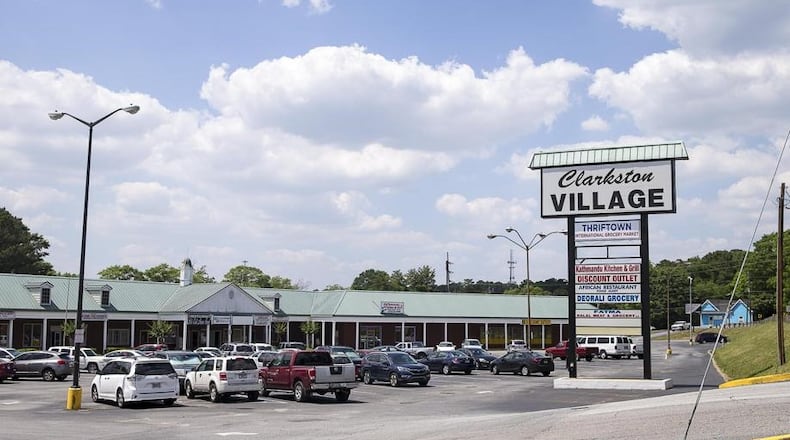An idea in a small DeKalb County city to chop the size of most residential lots in half has been tabled after residents raised concerns that the suggestions were based on a short report by a conservative-leaning think tank.
The five-page report, written for the city of Clarkston by a fellow at the R Street Institute, suggested a number of zoning changes that could have a major impact on the look and feel of the community. But residents say city leaders are attempting to increase Clarkston’s density in a way that would harm the city’s character. Residents also say some leaders went about promoting the changes in a way that bypassed best industry practices and minimized public input.
Zoning codes are essentially a set of rules where a government designates what can be built on each piece of land. Most residents only consider zoning when a new development is planned near their homes. But when the city began reconsidering its codes, the proposal angered some residents who saw R Street’s recommendations as too extreme.
Clarkston, in central DeKalb County, has since announced it will hire a professional planning firm to review the proposed changes.
“I just can’t stress enough,” Clarkston Mayor Ted Terry said, “that we are 100% committed to having a robust citizen- and resident-led process that actually will guide the final draft.”
Neighbors like Laura Hopkins said they will watch closely to see what comes of the professional review. She said it’s troubling that the R Street report is the “starting point” for the next firm’s review.
“The R Street report is still in sight,” Hopkins said. “I’m not sure what’s going to happen.”
‘Just a bad idea’
The episode began last summer when Councilman Jamie Carroll reached out to the R Street Institute, aiming to address issues he saw with the zoning in the city. Carroll hoped to find a way to boost residential density and encourage more commercial development, he said.
Nick Zaiac, a fellow in the “Commercial Freedom” division at R Street, wrote about five pages with several recommendations for how to improve the zoning policy in Clarkston. The new plan would clear the way for smaller home lots and allow for more commercial construction throughout the city.
“The goals are good,” said Susan Hood, a resident and former Atlanta city planner who specialized in zoning. “But … one size doesn’t fit all. And that’s the distinction between a bad approach and a professional approach.”
Hood said typically, cities hire a firm that specializes in zoning and planning to conduct an in-depth study on land use if they want to take on a zoning or planning issue.
For months, residents became worried about the process, in part because R Street is a think tank known for leaning right of center, while Clarkston is considered one of the most progressive and liberal cities in the state. The Washington, D.C.-based R Street, a nonprofit that does not affiliate with any political party, identifies itself as “on the political right.”
The R Street suggestions were converted into a formal zoning ordinance last year, and the city began conducting public hearings to gather feedback on the proposed changes.
In Clarkston, the minimum lot size for a single-family home in a low-density part of town is 0.23 acres. Under the proposed changes, that would be cut to 0.1 acre.
MORE DEKALB NEWS:
» Metro Atlanta ‘revolving sushi’ restaurant fails health inspection
» New Perimeter Center retail area would pave over pond, build new road
Zaiac also suggested raising the maximum building height and allowing mixed-use developments combining commercial and residential on its downtown corridor. It follows a strategy known as “upzoning,” which is meant to encourage economic development and has been relatively unheard of for a metro Atlanta suburb.
The changes were still on the agenda at a May 21 planning and zoning board meeting, where officials formally announced they would be forwarded to a firm to review. Residents took the opportunity to speak out against reducing residential lot sizes, with one saying there are “a lot of downsides.” Another neighbor said bluntly, “It’s just a bad idea and nobody wants it.”
Carroll and Terry said Clarkston is eyeing the prominent planning design firm TSW to instead examine the ideas in the R Street report and make recommendations to the city. A contract has not yet been voted on.
“Now we’re at this stage where we want to bring in the experts, if you will,” Terry said.
Clarkston itself is a unique community, with an estimated population of about 12,700. Considered the “most ethnically diverse square mile in America,” it has become known nationally as a welcoming place for refugees and other immigrants. Sitting just outside of I-285 and south of U.S. 78, Clarkston has a suburban feel in some of its neighborhoods, while its city center is peppered mostly with cultural shops and restaurants that reflect the community’s diversity. The average annual household income is about $43,700, according to the U.S. Census Bureau.
A push to increase access
Carroll said the changes in the R Street report could be a healthy way for Clarkston to increase density and bring more people and businesses to the city. He said there are not enough housing options, and the majority of the Clarkston’s housing stock is made up of apartments. The city also approved just two building permits between 2012 and 2016.
“I think Clarkston’s a great place to live. I just want more people to have access to Clarkston,” Carroll said.
Hood and other residents said they are not opposed to increased density and development, but they worry a major change in lot sizes could drive up the cost of living and speed up gentrification. An influx of new development could drive out the immigrants and refugees that make up much of Clarkston’s population, Hopkins said.
Carroll, however, said more housing could in turn lower the cost of living there, while making neighborhoods more walkable.
“The higher the lot sizes, the less access to housing, especially affordable housing. You’re forcing them to buy more land than they want,” Carroll said. “If you decrease the lot sizes, you allow people to buy a smaller home.”
The average home price in Clarkston is $193,500, according to the real estate database Zillow, significantly lower than the median home price in DeKalb County, which is about $285,000.
At its last City Council meeting, Clarkston approved a neighborhood of eight “tiny homes” built on half an acre. They are estimated to cost between $100,000 and $125,000.
» Follow DeKalb County News on Facebook and Twitter
Zaiac, who specializes in economic and regulatory issues, did not visit Clarkston to talk with residents or walk the city’s streets, instead using other resources he had on hand, according to Kevin Kosar, the vice president of policy at R Street. The report came at no cost to the city.
Resident Beverly Burks said she is relieved a firm like TSW is preparing to look into the proposed changes.
“It’s almost like, you wasted a year,” Burks, also a former council member, said about the process so far. “Having professional resources to do this type of documentation would have benefited everyone, and not have the community having to be inspectors and detectives and doing all of this research.”
About the Author
The Latest
Featured





